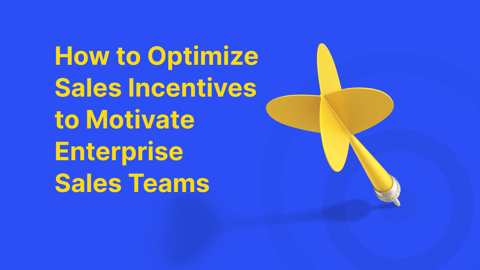Seasonal Renewal and Business Strategy
With the arrival of summer, it’s time for renewed tactics and innovative approaches in business growth. Understanding how to calculate revenue growth is crucial for developing an effective business strategy. Consistent revenue growth is essential in driving corporate performance and shareholder returns. Focusing on efficiently applying AI in sales performance, methods to optimize revenue, and refining your SPM approach will set your sales up for revenue growth in the coming months.
Here we outline essential steps to reinvigorate your business strategy and help ensure your sales efforts take form in the months ahead:
- Assess and Adjust Your Sales Goals: Take a look at last quarter’s achievements and set realistic yet challenging goals that reflect market conditions and your growth aspirations.
- Incorporate AI to Refine Sales Tactics: Utilize AI tools to analyze customer data, predict buying patterns, and personalize sales approaches. This can lead to more targeted and effective marketing efforts.
- Streamline Revenue Management Processes: Simplify procedures to manage revenue more efficiently. This could mean automating repetitive tasks or embracing new software solutions that provide clearer visibility into your sales pipeline.
- Foster Agility in Your Sales Teams: Creating an environment that encourages quick adaptation to changing conditions. Offer training and support to help sales teams effectively use new AI tools and data analytics.
- Optimize Incentive Structures: Make sure your compensation and incentives align with your revised strategies, encouraging behaviors that drive company-wide objectives and revenue growth.
- Cultivate Cross-Functional Collaboration: Use the fresh energy of summer to enhance cooperation across departments. Sales, marketing, operations, and finance should work together to identify opportunities for joint strategies that drive sales performance.
- Leverage Data for Informed Decision-Making: Apply insights gained from AI and analytics to make evidence-based decisions. This will likely lead to better resource allocation and a more strategic approach to targeting potential customers.
- Tap into New Markets and Segments: Consider whether your sales strategies can be extended into new markets or to different customer segments you haven’t previously tapped.
- Invest in Customer Relationships: You can use the insights gained from data analysis to deepen relationships with existing customers and identify potential new leads.
- Review and Improve Sales Channels: Determine if your current sales channels are effective or if you need to create additional channels or enhance existing ones to meet customer needs better.
By strategically applying these initiatives, businesses can position themselves to reap the rewards that often come with the onset of summer: a period of growth, renewal, and prosperity. Take this chance to reflect on past performances, retool your strategies, and step into the new season with a refined approach that promises fresh success for your sales endeavors. A well-defined growth strategy ensures sustained revenue growth and long-term success.
Applying AI in Sales Management - Embracing AI for Strategic Advantage
The landscape of artificial intelligence has permeated business sectors globally, opening new avenues for sales teams to pinpoint planning gaps, discover new opportunities, reduce manual tasks, and expedite data analysis. Organizations that swiftly integrate AI into their practices secure a strong position to readily adjust to changing markets confidently.
Applying AI in Sales Management: Strategic Innovations for a Competitive Edge
How can your organization tap into the power of AI to obtain a strong foothold in a fluid marketplace? Here are expanded strategies to consider:
Systematic Integration of AI Tools
Businesses aiming for market leadership must invest in a coherent integration of AI tools tailor-fitted to their sales strategies. This includes:
- Automating Data Analysis: Leveraging machine-learning algorithms to dissect large volumes of data, providing granular insights into consumer behavior and market trends.
- Enhancing Customer Relationship Management (CRM): Employing predictive analytics within your CRM system to forecast customer needs and personalize interaction, leading to improved customer retention rates.
- Optimizing Pricing Strategies: Using AI to dynamically adjust pricing based on real-time market conditions, competitor actions, and inventory levels.
Cultivating AI-Driven Insight Generation
Organizations that leverage AI effectively are often those that establish a culture of data-driven insight. This requires:
- Implementing Sales Intelligence Platforms: Harnessing platforms that automatically consolidate data from disparate sources, providing a single, comprehensive view of sales performance and customer interactions.
- Creating Predictive Sales Models: Developing models to predict future sales and create accurate forecasts, thus reducing the uncertainty inherent in sales planning.
Streamlining Sales Operations with AI Efficiency
AI can significantly streamline sales operations, improving the speed and efficiency of sales teams by:
- Automating Routine Tasks: AI can take over routine and repetitive tasks such as scheduling, follow-ups, and data entry, freeing sales representatives to focus on relationship building and strategy.
Promoting Agile Sales Strategy Adjustment
The real-time analytics provided by AI systems enable organizations to be nimble and adapt sales strategies quickly in response to market dynamism. This agile approach to sales allows for rapid pivoting and realignment of sales tactics as market conditions dictate.
Emphasizing AI Competence within Sales Teams
A strategic advantage is truly gained when sales teams are not only equipped with AI tools but also skilled in their use. Training programs focused on AI literacy can empower sales representatives to embrace AI fully:
- Fostering AI Literacy: Investing in training so that all team members understand AI capabilities and how they can be applied to their roles.
- Develop Peer-Led AI Mentorship: Encouraging tech-savvy team members to mentor their peers, fostering a collaborative environment of learning and innovation.
By adopting these extensive and thorough strategies, organizations will not just benefit from a single facet of AI but will effectively intertwine AI's vast capacities with the core functional dynamics of sales management. The seamless integration of AI into sales operations is the bridge that links current effectiveness to future growth—setting the stage for a company that operates with foresight, precision, and an enhanced strategic edge.
Early AI Adoption Fosters Market Leadership
Integrating AI technologies into company workflows signifies a commitment to market leadership. Our recent guide explains the potential impact of different AI systems in Sales Performance Management, offering a deep understanding of these technologies for success.
Triad of Revenue Growth Practices - Strategic Incentive Compensation and Revenue Growth Strategy
Managing revenue growth effectively through revenue growth management is crucial for any business. Developing a comprehensive revenue growth strategy is essential to align marketing, sales, and customer experience teams with fiscal goals.
Linking team efforts to fiscal goals effectively inspires a culture geared toward success. This thoughtful connection ensures collective company direction to revenue objectives, fostering an environment of shared ambition and enhanced performance.
Compensation and Revenue Growth Management Agility
Rapidly shifting markets demand innovative and responsive compensation planning methods. Quick adaptation enables companies to capitalize on arising prospects while mitigating associated challenges.
Aligning Tactics with Business Goals
Ensuring compensation strategies mirror overarching company aims inspires teams to pursue collective achievements, fostering enduring organizational prosperity. To achieve this, it is crucial to calculate revenue growth rate, as it helps align tactics with business goals. Understanding the company's revenue growth rate is significant for strategic alignment, enabling the evaluation of internal and external factors that affect revenue growth.
Hear it straight from those who’ve experienced transformational success. Let’s take a closer look at AFL’s journey:
AFL's Journey to Streamlined Data Management
Witness AFL's remarkable shift from cumbersome, error-ridden processes to a sleek, cost-effective data management system. This narrative is a testament to how AFL achieved a new level of data integrity and operational streamlining.
How AFL Improved Revenue Growth Rate
AFL, a global telecommunications company, was faced with unsustainable and unscalable manual processes to manage their data. By partnering with , AFL consolidated their sprawling data, yielding tangible rewards in data precision and financial efficiency. Within a mere six months of incorporating Varicent ELT into their operations, AFL noted significant progress in their strategic decision-making, aiding their market presence and sales advancement.Varicent, AFL consolidated their sprawling data, yielding tangible rewards in data precision and financial efficiency. Within a mere six months, AFL noted significant progress in their strategic decision-making, aiding their market presence and sales advancement. Now, AFL can transform their data in ways they couldn't before, providing a more efficient and trustworthy data management system.
Time For Consistent Revenue Growth
It’s an ideal time for businesses to refresh their approaches and plant the seeds for sustained sales growth by tracking revenue growth rate as a key performance indicator. Understanding growth rates is crucial for strategic planning and ensuring your business outgrows the industry. Embracing AI’s capabilities to sharpen sales performance and fine-tuning your strategies are essential steps in this process. AFL’s success is a prime example of how leveraging technology can lead to improved decision-making and efficiency. Let this season inspire a streamlined, data-driven approach in your business, ensuring your strategies are as dynamic and responsive as the market demands. For early-stage startups, tracking weekly revenue growth is particularly important for gauging progress. With these tools and methodologies in place, your business is poised for robust growth and long-term success.
Ready to harness the strategies that can drive your revenue growth?
Learn how customers like AFL connect their paths to revenue growth with expertly designed go-to-market strategies and actionable insights. Explore a suite of solutions that combines strategic planning, incentivization, and powerful AI insights to help organizations like yours chart an effective path to higher revenue.




